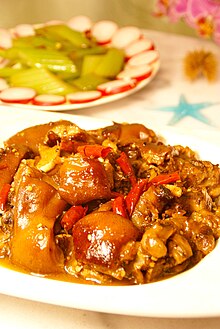This article includes a list of references, related reading, or external links, but its sources remain unclear because it lacks inline citations .(February 2013) |
| Part of a series on |
| Chinese cuisine |
|---|
 |

Red cooking, also called Chinese stewing , red stewing, red braising , or flavor potting, is a slow braising Chinese cooking technique that imparts a reddish-brown coloration to the prepared food. Red cooking is popular throughout most of northern, eastern, and southeastern China.
Contents
There are two types of red cooking:
- Hongshao (traditional Chinese : 紅燒 ; simplified Chinese : 红烧 ; pinyin :hóngshāo): can be done in less than 20 minutes[ citation needed ] and usually does not require much water
- Lu (traditional Chinese : 滷 ; simplified Chinese : 卤 ; pinyin :lǔ): usually requires prolonged cooking of up to several hours and the items must be submerged in the cooking liquid.

